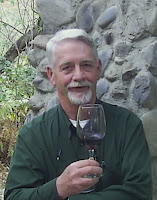Always on the lookout for something new to try in the world of wine, we stumbled upon a tienda just off the main square called "Vinos y Licores Vilcabamba". What I had expected to be a typical Ecuadorian licoria turned out to be something entirely different. Typically, the average liquor store in Ecuador offers a modest selection of wines and lots of beer. You will also find the ever present Zuhmir plus a variety of other hard liquor, mostly rum and tequila. This was different, however, a boutique shop offering only one single brand "Vinos y Licores Vilcabamba". Within the single brand was a plethora of choices. There were dozens of wines made from many of the fruits grown in Ecuador, ranging from uvas (grapes) to mora (blackberry). There were also several varieties of flavored liquors.
 |
| The Wine Guy and Pilar with three selections! |
 |
| The label |
Everything had an identical bottle and label with the only difference being a descriptive line of simple identification of the contents (vino de uva, vino de mora, licor de cafe, etc). There was no information as to fruit varietals utilized nor date of production, methods of aging, etc. No tastings were offered either and with my limited Espanol (the personable proprietress, Pilar, spoke virtually no English), there wasn't much opportunity to inquire as to flavor profiles, so we decided to guess and gamble on a few selections. Everything was identically priced at a very reasonable seven dollars a bottle so we settled on three choices: a grape wine (vino de uva), a blackberry wine (vino de mora) and a coffee liquor (licore de cafe). Suspecting that we may have purchased a pair of fruit bombs and some alcohol infused coffee beverage, we thanked our hostess, paid for our purchases and went on our way.
Back at our hosteria, Mrs. Wine Guy and I elected to open and sample the Licore de Cafe, figuring that, as a liquor, it could probably best stand being opened for the couple of days before our return home to Cuenca. It turned out to be more than just alcohol infused coffee so it somewhat exceeded our expectations. It did fall short of being a full-fledged Kaluha and certainly wasn't Mrs. Wine Guy's favorite liquor, a Tia Maria. However, since both of those, in Ecuador, cost at least six times our purchase, we congratulated ourselves on discovering a "poor man's Kaluha".
 |
| Regular wine cork along side the suspect Vino Vilcabamba cork |
It was after our return home that we got the opportunity to sample the wines. The vino de mora was first and it turned out to a real disappointment because it had turned bad. A distinctive odor that I often describe as highly overcooked raisins and a very dark amber color strongly suggested the contents had been oxidized. That indeed was the case. Despite some vague lingering hints of fruit, and a ton of residual sugar, it hard to tell that this was made from mora and the entire bottle was undrinkable. I had briefly noted that the cork seemed unusually short on opening but the soured contents prompted a closer examination. I discovered a rough edge to one surface suggesting a whole cork had been cut in two. The cork was very cracked along its length and that (along with some possible lack of rotation in inventory) had led to aging and oxidation of what may very well have a nice sweet fruity wine in its beginning.
After declaring the vino de mora a loss, we proceeded to the vino de uva. The cork was similar to the previous bottle with the same tell tale rough edged, half cork size, somewhat supporting my hypothesis that the bottler was cutting regular corks in half in order to seal more bottles at a lower cost. The vino de uva was better but also showed some signs of early oxidation particularly on the finish. It had not, however, progressed to the point of making the wine undrinkable. With a little additional chilling, we utilized it as an after dinner dessert, still enjoying some of its apparent sweetness and fruitiness.
 |
| A possible vineyard and winery site? |
While Mrs. Wine Guy and I will likely return to this beautiful area, but it is probably unlikely we will gamble again on a selection from Vinos y Licores Vilcabamba. That's a shame, because what was detectable underneath the oxidation and as well as the acceptable taste of the liquor de cafe suggests that at the time of bottling, these may have been very viable products but short cuts in corkage and perhaps lack of care in storage have made the entire product line suspect. We can only hope that might change. The Wine Guy thinks Ecuador can and should have some potential in wine production, especially in the lower Andes ranges such as Vilcabamba. In fact we spotted what we thought was a great site for a vineyard and winery there.
Here's hoping you have great results and make some exciting discoveries as you do your own explorations in the wonderful world of wine. Sainte!


No comments:
Post a Comment